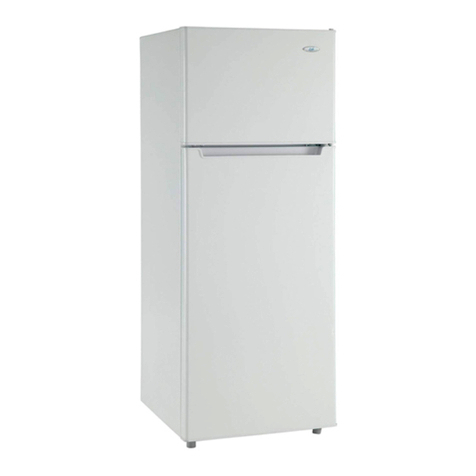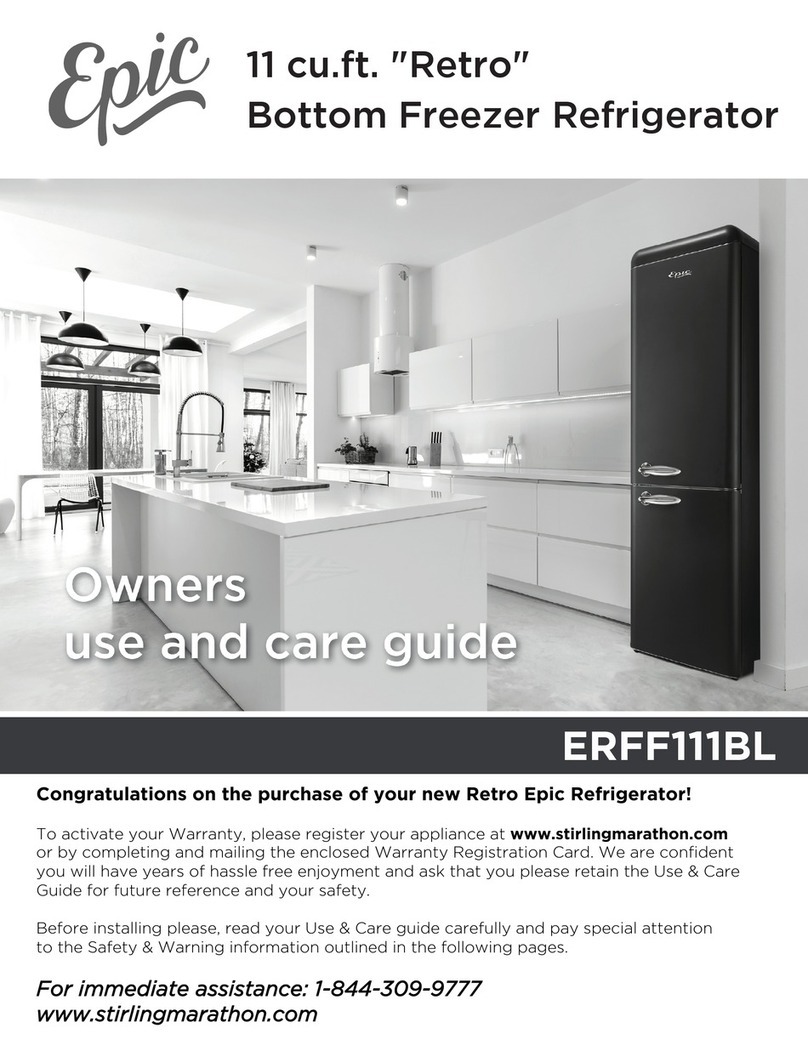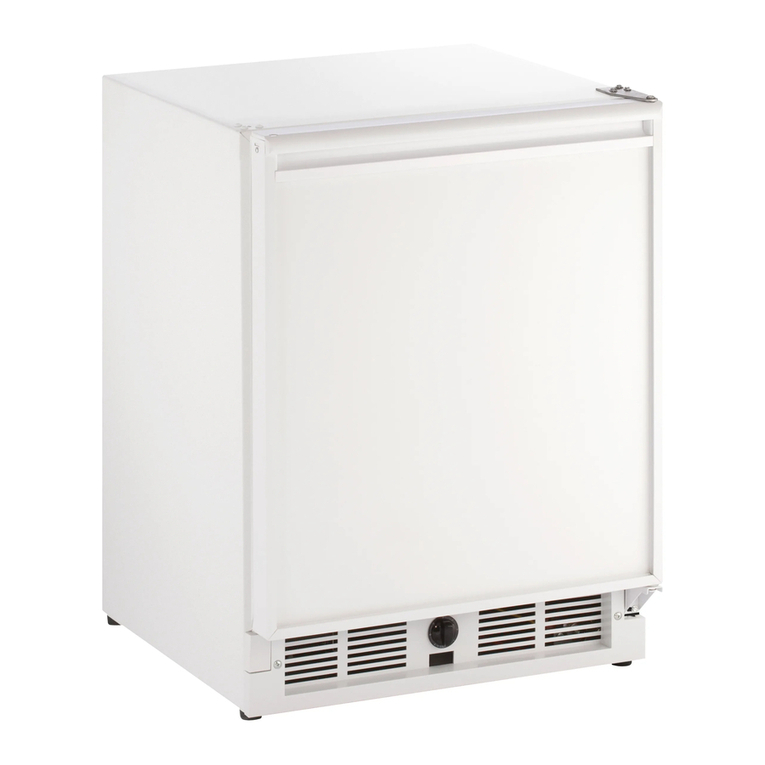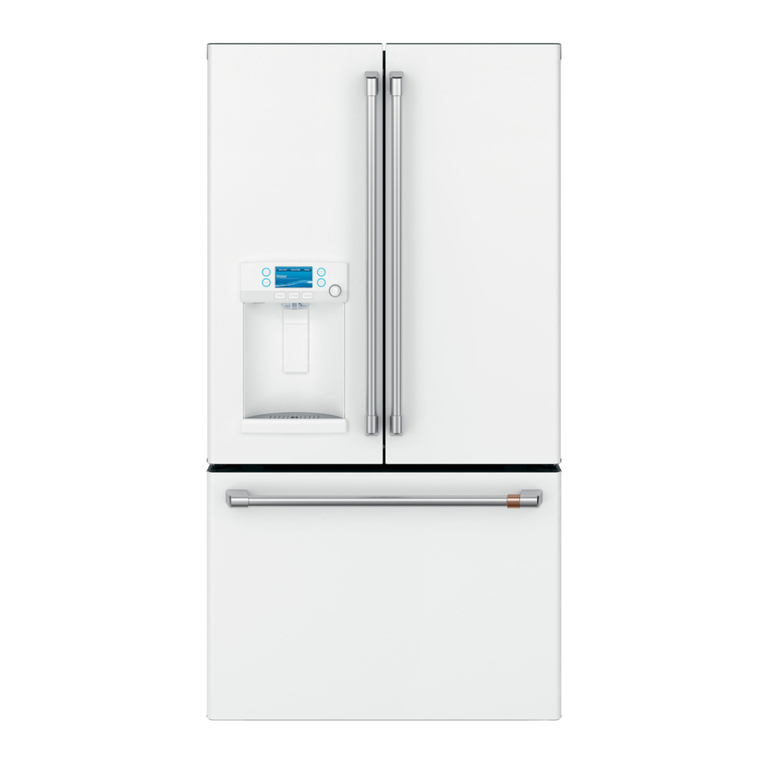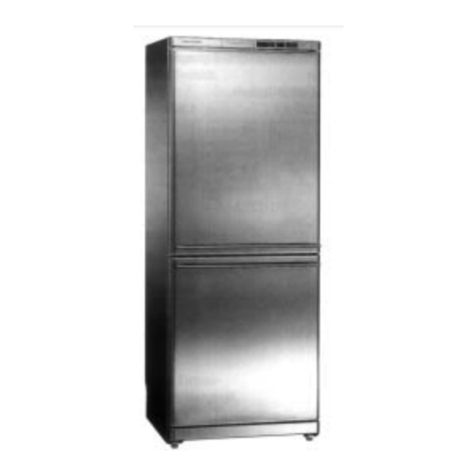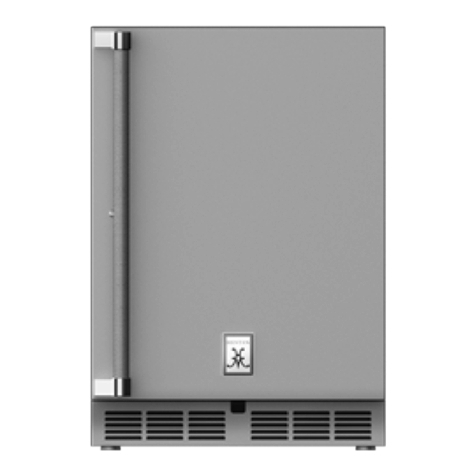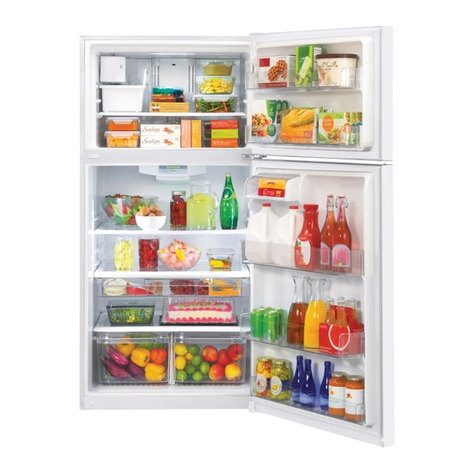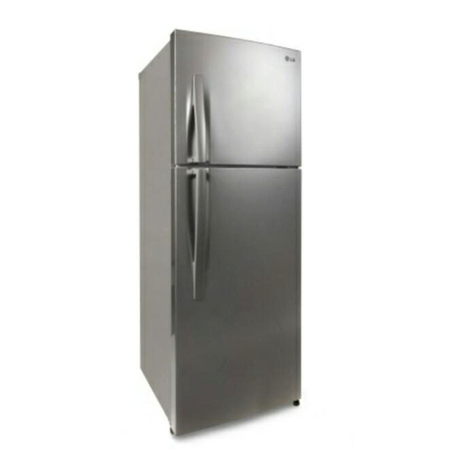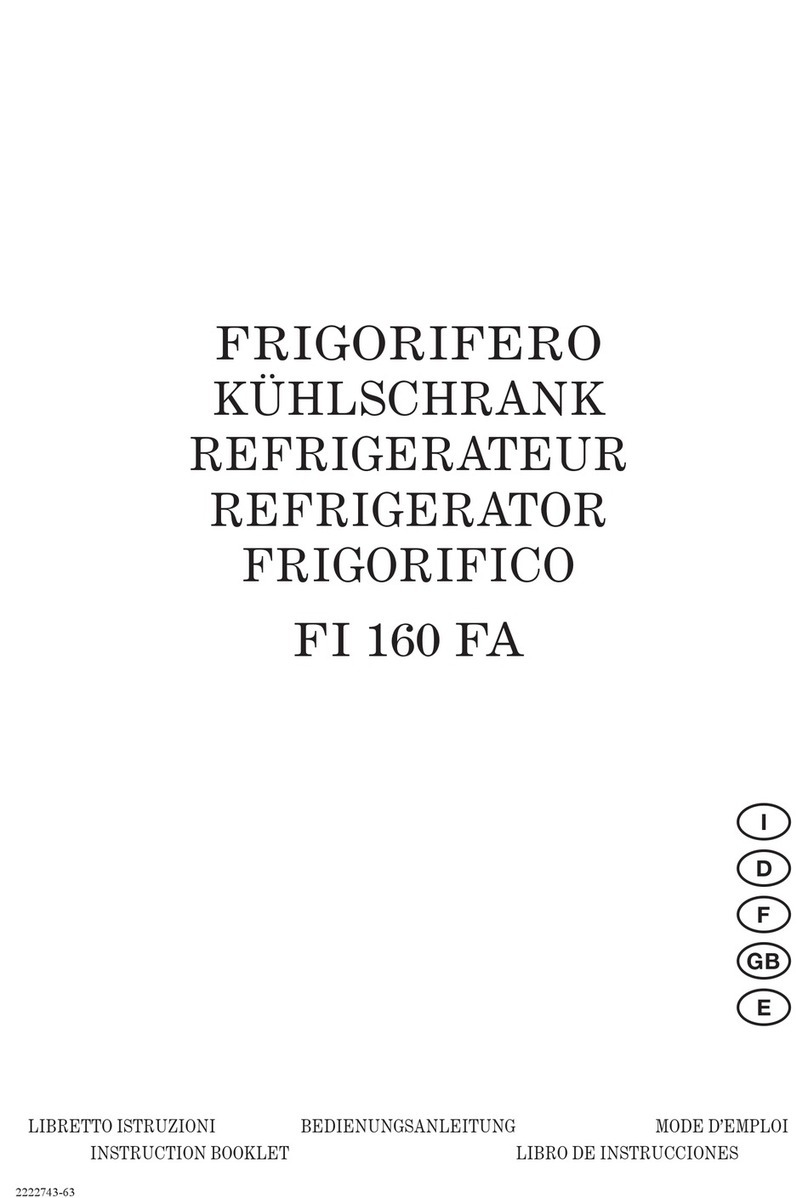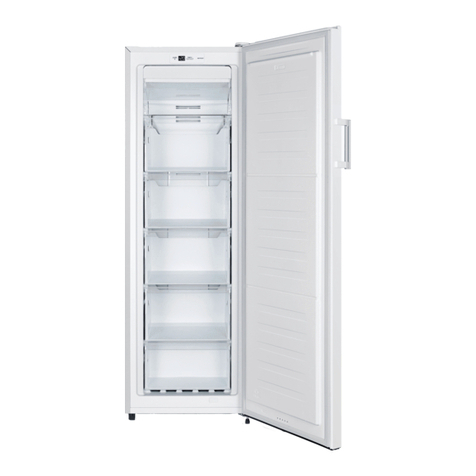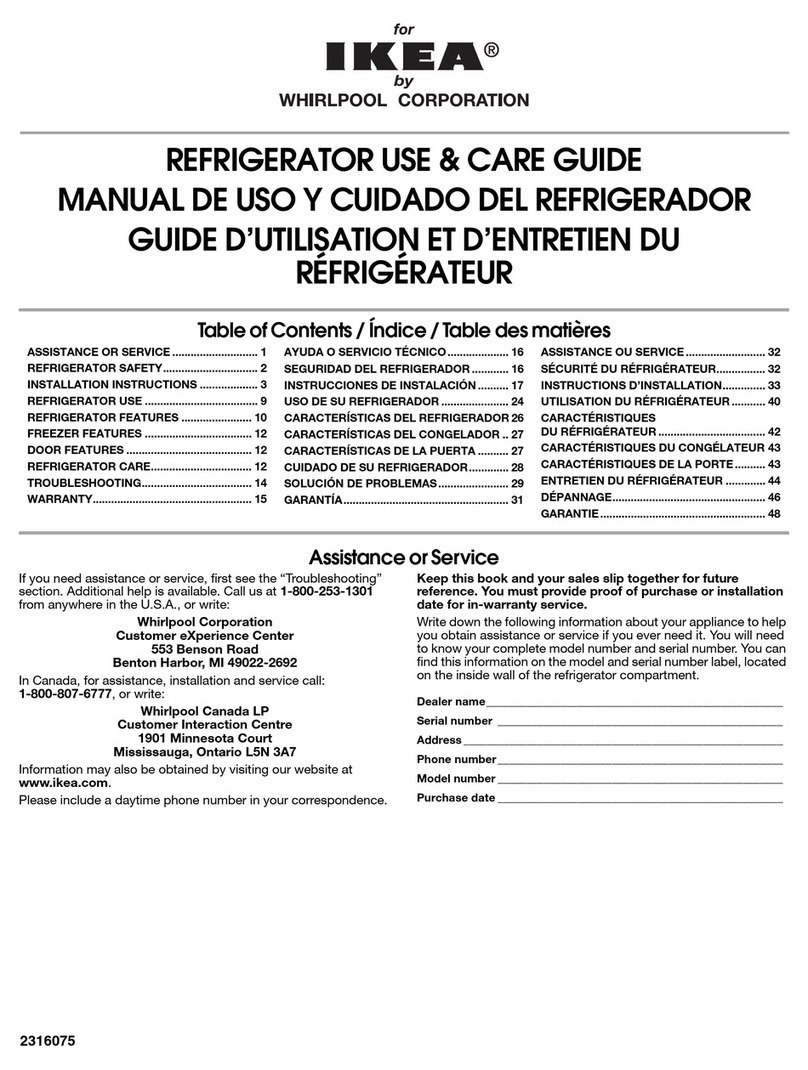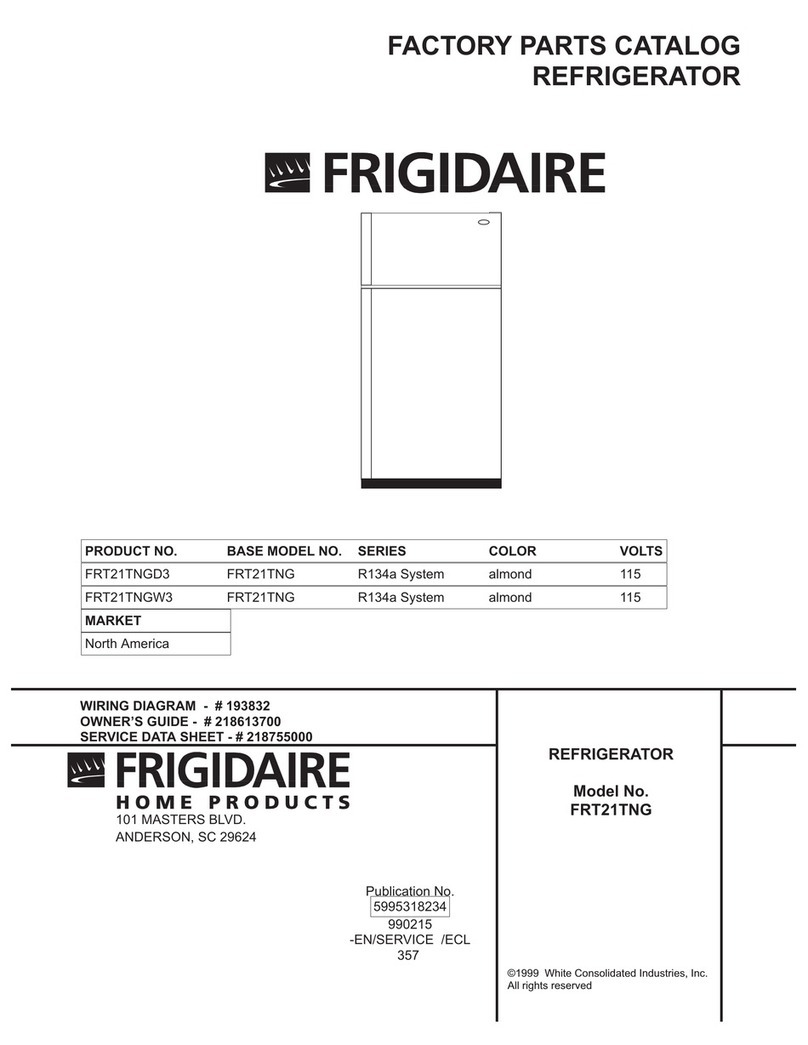Epic EFF170W User manual

Frost Free Refrigerator
EFF148W | EFF170W | EFF170SS
Congratulations on the purchase of your new Epic Refrigerator!
To activate your Warranty, please register your appliance at www.stirlingmarathon.com
or by completing and mailing the enclosed Warranty Registration Card. We are confident
you will have years of hassle-free enjoyment and ask that you please retain the Use &
Care Guide for future reference and your safety.
Before installing please, read your Use & Care Guide carefully and pay special attention to
the Safety & Warning information outlined in the following pages.
For immediate assistance: 1-844-309-9777
www.stirlingmarathon.com
Model EFF170SS shown above

Twin Crisper
2
Important Safety Instructions
WARNING
To reduce the risk of fire, electrical shock, or injury follow these basic
precautions when using your appliance.
•
•
Completely remove the doors.
Leaves the shelves in place so that children not may easily climb inside.
Before you discard or recycle your old refrigerator
1. WARNING----Keep ventilation openings, in the appliance enclosure or built-in structure, clear of obstruction.
2. WARNING----Do not use mechanical devices or other means to accelerate the defrosting process, other than those
recommended by the manufacturer.
3. WARNING----Do not use electrical appliances inside the appliance
4. WARNING----DANGER: Never allow children to play with, operate, or crawl inside the appliance. Risk of child
entrapment.
5. WARNING----GROUNDING INSTRUCTIONS This appliance must be grounded. In the event of an electrical short circuit,
grounding reduces the risk of electrical shock by providing an escape wire for the electrical current. This appliance is
equipped with a cord having a grounding wire with a grounding plug. The plug must be plugged into an outlet that is
properly installed and grounded.
6. DO NOT USE AN EXTENSION CORD
7. Use an exclusive 115V wall outlet. Do not connect your refrigerator to extension cords or together with any other
appliance in the same wall outlet. Do not splice the cord.
8. Always unplug before any maintenance or service on the appliance.
9. If a component is damaged, it must be replaced by the manufacturer, its service agent or similar qualified persons in
order to avoid a hazard.
10. Follow local regulations regarding disposal of the appliance due to flammable refrigerant and blowing gas. All
refrigeration products contain refrigerants, which under the guidelines of federal law must be removed before
disposal. It is the consumer’s responsibility to comply with federal and local regulations when disposing of this product.
11. This appliance is intended to be used in household and similar environment such as:
a) Staff kitchen, workshop, office and other working environments;
b) Farmhouses and by clients in hotels, motels and other residential type environments;
c) Bed and breakfast type environments;
d) Catering and similar non-retail applications.
12. Do not store or use gasoline or any inflammable liquors and liquids inside or in the vicinity of the refrigerator.
13. Do not use an extension cord with t his appliance. If the power cord is too short, have a qualified electrician install an
outlet near the appliance. The use of an extension can negatively affect the appliance’s performance

3
OVERVIEW
Note: Above picture is for reference only. The actual appliance may be slightly different.
1. Freezer Door Rail
2. Refrigerator Door Bin
3. Freezer Shelf
4. Freezer Temperature Control
5. LED Light
6. Refrigerator Temperature Control
7. Adjustable Tempered Glass Shelves
EFF148W - 2 Shelves
EFF170W/SS - 3 Shelves
8. Glass crisper cover
9. Crisper with adjustable divider
10.Adjustable Feet

•This appliance is designed to be free-standing only, and should not be recessed or built-in.
•This unit is not designed for use in a garage or any other outside installation
•Ambient temperature below 50°F (10°C) or above 85°F (29.4°C) will hinder the performance of this
appliance.
•Avoid locating the refrigerator in moist areas.
•Locate the refrigerator away from direct sunlight and sources of heat (stove, heater, radiator, etc.).
•Direct sunlight may affect the acrylic coating and heat sources may increase electrical consumption.
•Select a location with enough space for the refrigerator doors to open easily;
•Select a location with level (or nearly level) flooring;
•Allow sufficient space to install the refrigerator on a flat surface;
•Allow clearance to the right, left, back and top when installing. This will help reduce power consumption
and keep your energy bills lower.
Installing your refrigerator
Levelling the refrigerator
To do this adjust the two levelling feet at front of the unit.
If the unit is not level, the doors and magnetic seal alignments will
not be covered properly
4
At least 2''
Installation
At least 2''

5
Tool required: Philips screwdriver, Flat bladed screwdriver,
•Ensure the unit is unplugged and empty.
•To take the door off, it is necessary to tilt the unit backwards. You should rest the unit on something solid so
that it will not slip during the door reversing process.
•All parts removed must be saved to do re-installation of the door.
•Do not lay the unit flat as this may damage the coolant system.
•CAUTION: To avoid injury, we recommend someone assist you during the door reversal process.
1. Unscrew the top hinge cover and then unscrew
the top hinge. Then lift the upper door and place it
on a soft pads to avoid scratches and damage.
2.Remove the top left screw cover.
3.Unscrew the middle hinge. Lift the refrigerator
door and place it in a safe place to protect it from
damage and scratches.
4.Move shaft sleeve and pinhole plug from left
side to right side.
5.Move the middle hinge hole covers from the left
side to the right side. 6.Unscrew bottom hinge. Then remove the
adjustable feet from both.
Changing the Reversible Door

6
7.Remove the washer and nut that secure the
hinge pin to the hinge, then remove the pin and
screws with the washer and nut into to left hole
hinge.
9. Move the bottom hinge hole covers from the left
side to the right side.
10.Make the middle hinge reverse the direction 180º,
then transfer it to the left property position. Make the
middle hinge pin in the upper hole of the lower door,
then tighten the bolts.
11.Place the upper door back on. Ensure the door is
aligned horizontally and vertically so that the seal
transfer it to the left property position. Make the
middle hinge pin in the upper hole of the lower door,
then tighten the bolts.
12.Place the top left cover to the right side and
affix it by a screw.
8. Transfer the lower door to the property position.
Replace both adjustable feet.
Changing the Reversible Door

7
Refrigerator section
•Your refrigerator has one control for regulating the temperature. The
temperature control is located on the top left-handed corner of the
refrigerator compartment.
•The first time you turn the unit on, adjust the temperature control
knob to “5” and run for at least 2 hours before putting foods inside.
This will ensure the cabinet is thoroughly chilled before food is put in.
•The range of the REFRIGERATOR temperature control is from
position "1" the warmest to "5" the coldest. Adjust the temperature
control to the setting that best suits your needs. The setting of “3”
should be appropriate for home or office refrigerator use
•If the unit is unplugged, loses power; you must wait 3 to 5 minutes before restarting the unit. If you attempt
to restart before this time delay, the refrigerator will not start.
•Large amounts of food will lower the cooling efficiency of the appliance.
•Do not place the foods on the air ducts and leave spaces for airflow.
•If you choose to change the thermostat setting, adjust the thermostat control by one increment at a time.
Allow several hours for the temperature to stabilize between adjustments.
•Adjusting the temperature control in the refrigerator compartment will affect the temperature in both the
refrigerator and the freezer compartment.
Note
Freezer section
•Your refrigerator has one control for regulating the temperature. The
temperature control is located in the middle of the freezing chamber.
•The first time you turn the unit on, adjust the temperature control knob
to “FREEZER MAX” and run for at least 2 hours before putting food
inside. This will help ensure the cabinet is thoroughly chilled before
food is put in.
•The range of the FREEZER temperature control is from position
"FRIDGE MIN" the warmest to "FREEZER MAX" the coldest. Adjust
the temperature control to the setting that best suits your needs. The
setting of “MED” should be appropriate for home or office refrigerator
use.
•This compartment is designed for the long-term storage of frozen food.
•The storage life of frozen foods varies and the recommended storage time should not be exceeded.
•Place frozen food into the freezer as quickly as possible after purchase. If there are instructions on the
packet, carefully follow these instructions regarding storage times.
Note
Temperature Control

8
Hints for storage of frozen food
To obtain the best performance from this appliance, you should:
•Make sure that the commercially frozen foodstuffs were adequately stored by the retailer;
•Be sure that frozen foodstuffs are transferred from the food store to the freezer in the shortest possible time;
•Do not open the door frequently or leave it open longer than necessary;
•Once defrosted, food deteriorates rapidly and cannot be refrozen;
•Do not exceed the storage period indicated by the food manufacture.
Hints for refrigeration
To obtain the best performance:
•Do not store warm food or evaporating liquids in the refrigerator;
•Cooked foods, cold dishes, etc. These should be covered and may be placed on any shelf;
•Fruit and vegetables: these should be thoroughly cleaned, dried, and place in the crisper drawer(s).
•Butter and cheese: These should be placed in airtight containers or wrapped in aluminum foil or polythene bags to
exclude as much air as possible;
•Milk bottles: these should have a cap and should be stored in the balconies on the door;
•Bananas, potatoes, onions and garlic, if not packed, must not be kept in the fridge.
For hygienic reasons the appliance interior, including interior accessories, should be cleaned regularly.
Caution! The appliances may not be connected to any power supply during cleaning. Danger of electrical shock!
Before cleaning switch the appliance off and remove the plug from the outlet, or switch off the circuit breaker/fuse.
Never clean the appliance with a steam cleaner. Moisture could accumulate in electrical components, danger of
electrical shock! Hot vapours can lead to the damage of plastic parts. The appliance must be dry before it is placed
back into service.
Important! Ethereal oils and organic solvents can attack plastic parts, e.g. lemon juice or the juice from orange
peel, butyric acid, a cleaner that contains acetic acid.
•Upon installation of your new appliance, it is recommended that it be cleaned thoroughly.
•Wash the inside with a damp warm cloth soaked in lukewarm water and baking soda solution. The solution should be
about 2 tablespoons of baking soda to a quart of water.
•Be sure to keep the door gasket (seal) clean to keep the unit running efficiently.
•The outside of the refrigerator should be cleaned with mild detergent and warm water.
•Dry the interior and exterior with a soft cloth.
•To keep the inside sanitary without odor or dirty, regular cleaning required at least once a month.
•Do not allow such substances to come into contact with the appliance parts;
•Do not use any abrasive cleaners;
Daily Use
Cleaning

9
Keep ventilation openings, in the appliance enclosure or built-in structure, clear of obstruction. Do not
use mechanical devices or other means to accelerate the defrosting process, other than those
recommended by the manufacturer.
Do not change or damage the refrigerant circuit.
Do not store explosive substances such as aerosol cans with a flammable propellant in this appliance.
During transportation and installation of the appliance, be certain that none of the components of the
refrigerant circuit have become damaged.
It is dangerous to alter the specifications or modify this product in any way.
Any damage to the cord may cause a short circuit, fire and/or electric shock.
This appliance is intended to be used in residential household, office or light commercial applications
such as Hotels and College Dorms.
All electrical components (plug, power cord, compressor and, etc.) must be replaced by a certified
service agent or qualified service personnel.
The refrigerant contained within the compressor of the appliance is isobutene (R600a) which is
environmentally friendly but flammable.
Make sure that the power cord is not crushed or damaged at the back of the appliance. A crushed or
damaged power cord may overheat and cause a fire.
The power cord must not be lengthened.
Make sure that you can come to the power cord of the appliance Do not pull the unit by the power cord.
If the electrical outlet is loose, do not insert the power plug. There is a risk of electric shock or fire.This
appliance is heavy. Care should be taken when moving it.
Do not remove or touch items from the freezer compartment if your hands are damp/wet, as this could
cause skin abrasions or frost/freezer burns.
Avoid prolonged exposure of the appliance to direct sunlight.
Locate the refrigerator away from direct sunlight and sources of heat (stove, heater, radiator, etc.).
Direct sunlight may affect the acrylic coating and heat sources may increase electrical consumption.
Ambient temperature below 50°F (10°C) or above 85°F (29.4°C) will hinder the performance of this
appliance. This unit is not designed for use in a garage or any other outside installation
Important Warning

10
You can solve many common refrigerator problems easily, saving you the cost of a possible service
call. Try the suggestions below to see if you can solve the problem before calling for service.
Problem Possible Causes
The refrigerator does not operate. •
The power cord is unplugged.
•
The circuit breaker is tripped/fuse blown.
The compressor turns on and off •
The room temperature is warmer than normal
•
A large amount of food has been added to the refrigerator.
•
The door is left open or is frequently opened.
•
The temperature control is not set correctly
•
The door is not closed completely.
•
The door gasket does not seal properly.
•
The refrigerator does not have the correct clearances.
•
The refrigerator has recently been disconnected for a period of time.
•
The temperature control is not set correctly.
•
The door is left open or is not set correctly.
•
The door gasket does not seal properly.
•
A large amount of warm or hot food was stored recently.
Wait for the refrigerator to reach its selected temperature.
•
The refrigerator has recently been disconnected for a for a while
•
The door is slightly open or is frequently opened.
•
The door is not sealed properly.
Bubbling or gurgling sounds.
(like boiling water)
•
This is the normal sound of refrigerant (used to cool the refrigerator)
circulating throughout the system
The door will not close properly. •
The refrigerator is not on a level surface.
•
The gasket is dirty.
•
A storage basket is out of position.
•This is normal. Metal parts undergo expansion and contraction. The sound will
level off or disappear as the refrigerator runs.
Popping or crackling sounds
when the compressor comes on.
The temperature inside the
refrigerator is too warm.
Vibrating or rattling.
(slight vibration is normal)
The temperature of the external of
the refrigerator's surface is warm •
The exterior refrigerator walls can be as much as 30°F warmer than room
temperature.
•
This is normal while the compressor works to transfer heat from inside the
refrigerator cabinet.
•
Levelling legs need adjusting.
•
Refrigerator is placed on an uneven or weak surface.
•
The refrigerator is touching the wall. Re-level the refrigerator and move it away from
the wall.
Moisture collects inside the refrigerator.
•
Is normal in hot and humid weather. Air carries moisture into the refrigerator when
doors are opened
Moisture forms on the
outside of refrigerator.
For any questions or concerns, please contact us at
[email protected] or visit us at www.stirlingmarathon.com
Troubleshooting

Troubleshooting
11
V.01/2021
1 Year Limited Warranty
When operated and maintained according to the instructions in the Use & Care Guide, EPIC a registered trademark of Stirling
Marathon Limited agrees to repair or replace this product for 1 year from the date of original purchase and/or agrees to pay for
parts and service/labour required to correct defects in materials or workmanship. Any Service must be approved and provided
by an Authorized Stirling Marathon Service provider. YOUR EXCLUSIVE REMEDY UNDER THIS LIMITED WARRANTY
SHALL BE PRODUCT REPAIR OR REPLACEMENT AT THE SOLE DISCRETION OF STIRLING MARATHON LIMITED AS
PROVIDED HEREIN. This limited warranty is valid only in Canada and the Continental United States with proof of original
purchase and confirmed warranty registration.
Carry-In: The original purchaser must deliver or ship the defective product to an authorized Stirling Marathon Service present
a copy of the original bill of sale or Warranty Registration Confirmation.
In-Home: Contact Authorized Service Center and provide a copy of the Original bill of sale or Warranty Registration Card. If
you are in a remote area or the closest Authorized Service Center is further than 100 km (60 miles), you will be required to
deliver the appliance to the closest Service Center at your expense.
Stirling Marathon is not responsible or liable for any spoilage or damage to food or other contents of this appliance, whether
due to any defect of the appliance, or its use, whether proper or improper.
Items Excluded from Warranty
•Damages due to shipping or improper installation.
•Damages due to misuse or abuse.
•Content losses due to failure of the unit.
•Commercial or Rental Use Limited to 90 days Parts & Labour.
•Plastic parts such as door bins, panels, door shelves, racks, light bulbs, etc.
•Punctures to the evaporator system due to improper defrosting of the unit.
•Service or Repair by unauthorized service technicians.
•Service calls that do not involve defects in material and workmanship such as instruction on the proper use of the product, door reversal or improper
installation.
•Replacement or resetting of house fuses or circuit breakers.
•Delivery costs incurred as the result of a unit that fails.
•Expenses for travel and transportation for product service if your appliance is located in a remote area where service by an unauthorized service
technician is not available.
•The removal and reinstallation of your appliance if it is not installed correctly or is in a inaccessible location, as per the published installation
instructions.
•Liability under this warranty is limited to repair, replacement or refund. If a replacement unit is not available or the unit cannot be repaired, liability is
limited to the actual.
•Purchase price paid by the consumer.
•This warranty applies only to the original purchaser and does not extend to any subsequent owner(s) and is non-transferable.
•No warranty or insurance herein contained or set out shall apply when damage or repair is caused by any of the following:
accident, alteration, abuse or misuse of the appliance such as inadequate air circulation in the room or abnormal operating conditions (extremely high
or low room temperature).
•Use for commercial or industrial purposes (i.e. If the appliance is not installed in a domestic residence). Fire, water damage, theft, war, riot, hostility,
acts of God such as hurricanes, floods etc.
•Service calls resulting in customer education.
•lmproper installation (ie. Building-in of a free-standing appliance or using an appliance outdoors that is not approved for outdoor application).
How to Obtain Service
For Service or Assistance please contact us at:
Items Excluded from Warranty
This manual suits for next models
3
Table of contents
Other Epic Refrigerator manuals




